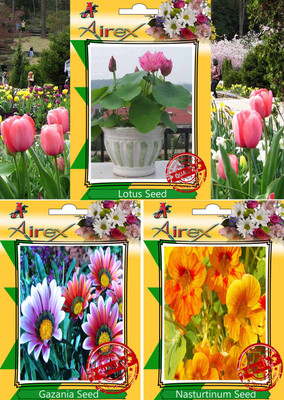Airex Lotus, Gazania, Nasturtium Mixed Seed(25 per packet)
Quick Overview
Product Price Comparison
Lotus Flower Seeds:Description:The sacred lotus is a perennial aquatic plant with rhizomes (often mistakenly called 'roots') that grow in the mud at the bottom of shallow ponds, lakes, lagoons, marshes and flooded fields. Its large, peltate (with the leaf-stalk attaching to the centre, rather than the edge) leaves rise above the water surface on 1 to 2 m long petioles. The strikingly water-repellent leaf surface has inspired the term 'lotus effect'. This term describes the leaves' self-cleaning capacity which is a result of dirt particles being picked up by water droplets due to a complex nanostructure of the leaf surface, which minimises adhesion. Gazania Flower Seeds:Description:Overview: Leaves typically linear to linear-lanceolate (narrow and tapering to a point), up to 10 mm wide. The leaves are pinnately lobed (feather-like) and held in rosettes arising from a stout, woody crown (that part of the stem at the ground surface). The leaves are hairless on the upper surface, but the undersides are thickly covered with soft, white hairs, except around the midrib.Flowers: The solitary flower head (capitulum) is up to 7 cm wide and held above the leaves on a stem 10 cm or more long. The capitulum consists of two types of florets: the ŌĆśray floretsŌĆÖ at the margins and the ŌĆśdisc floretsŌĆÖ in the centre. The ray florets are generally golden yellow, often with a dark base, but are occasionally white with a yellow band near the base. The disc florets are yellow to reddish-orange.Gazania linearis is divided into two varieties: G. linearis var. linearis and G. linearis var. ovalis. Gazania linearis var. ovalis has broader leaves that are lanceolate (spear shaped) to elliptic (broadest at the middle with two equally rounded ends) and up to 25 mm wide. Both varieties are from the same region of South Africa. Nasturtium Mixed Flower Seeds:Description:Nasturtium (Tropaeolum Majus Jewel Mix) - Few flowers light up the garden like Nasturtiums do! Grow this lovely annual from flower seeds and have blooms from June until first frost. The Jewel mix blossoms are 2 - 3 inches across and come in shades of red, orange and yellow. The leaves are rounded or shaped like a shield and have a central leaf stalk. The leaves, flowers and seeds are edible, with the leaves having a peppery flavor which makes a great addition to your salads. The seeds were actually used as a pepper substitute during WWII, or you can pickle the seeds when they are still green.Nasturtium Vine does best when it is left alone. It will tolerate most any soil type, but prefers not to be fertilized. Over-fertilization will produce lovely foliage, but no flowers. Keep watered, but allow the soil to dry out between waterings. Climbing Nasturtium is used as a companion plant for the vegetable garden. It is said that the peppery-flavored leaves ward off many insects. The plant likes a full sun place in the garden in cooler climates. For the hottest regions, afternoon shade is preferable to plants. Tropaeolum Majus plants will grow anywhere as an annual, but they will only survive as a perennial in frost-free zones.Plant Nasturtium seeds directly outdoors in the spring. The seedlings do not transplant well into the garden when started indoors. Before sowing Nasturtium seeds, soak the flower seeds overnight in warm water. The next day, plant the flower seeds 1/2 inch deep in an area that gets at least 6 hours of direct sun each day. Have the soil worked so that it's fine and light. The flowers will appear 8 - 12 weeks after being sown from flower seeds.


